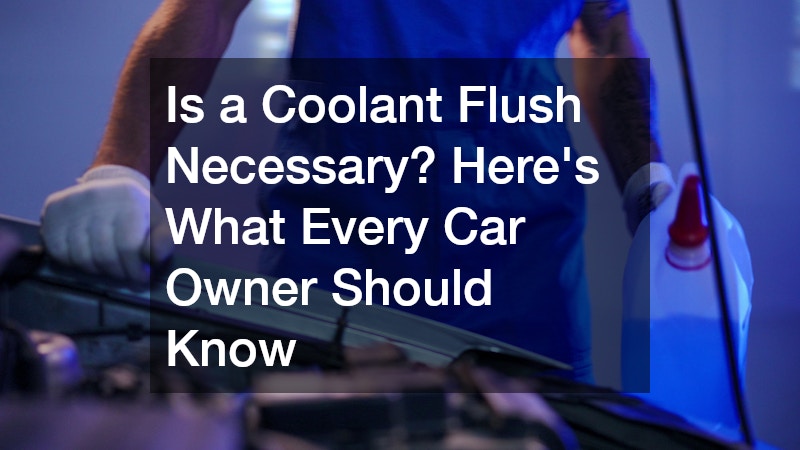

Every car owner knows the importance of oil changes, but many overlook the cooling system—until something goes wrong. Your engine generates a lot of heat when running, and the coolant (or antifreeze) is responsible for regulating that heat. Over time, coolant breaks down and becomes contaminated with rust, scale, and debris. When this happens, it can’t protect your engine as effectively. That’s where a coolant flush comes in. But is a coolant flush necessary for every car?
This article will break it down so you know when and why to consider one, and what happens if you don’t.
What Is a Coolant Flush and How Does It Work?
A coolant flush is a maintenance process where the old, dirty coolant is completely drained from your radiator and replaced with fresh fluid. Unlike a simple drain-and-fill, a full flush also cleans out rust, sludge, and mineral deposits that can build up inside your cooling system.
During a coolant flush:
- The radiator and engine block are emptied of all coolant.
- A cleaning solution may be used to remove contaminants.
- The system is filled with fresh antifreeze and deionized water.
This process restores the system’s ability to prevent overheating and corrosion. It’s more than just a routine service—it’s preventive care for your engine.
Is a Coolant Flush Necessary for Every Car?
Many car owners ask, “Is a coolant flush necessary if my car is running fine?” The answer depends on several factors, including your vehicle’s age, mileage, and maintenance history.
Here are some situations where a coolant flush is recommended:
- You’ve driven over 50,000 miles without a flush.
- You notice signs of overheating or coolant leaks.
- Your coolant looks rusty, brown, or sludgy.
- Your vehicle’s manual recommends it at a certain interval.
Modern vehicles can go longer between flushes, but that doesn’t mean you can skip it entirely. Skipping a needed flush can lead to clogged radiator hoses, inefficient heat transfer, and even engine failure. Regular flushes extend your car’s life and keep it running efficiently.
How Often Should You Flush Your Coolant?

Not all vehicles follow the same coolant flush schedule. Check your owner’s manual first—it will tell you exactly when your manufacturer recommends one.
As a general rule:
- Older vehicles (10+ years): Every 30,000 to 50,000 miles
- Newer vehicles with extended-life coolant: Every 100,000 miles or 5 years
That said, these timelines aren’t one-size-fits-all. If you regularly drive in traffic-heavy areas, haul heavy equipment, or live in regions with extreme temperatures, your cooling system may require more frequent attention. When uncertain, it’s a good idea to consult your mechanic during your vehicle’s routine check-ups.
What Happens If You Skip a Coolant Flush?
Neglecting your cooling system can lead to some serious—and costly—issues. Coolant doesn’t just keep your engine cool. It also:
- Prevents internal corrosion
- Maintains proper boiling and freezing points
- Protects the water pump and thermostat
When coolant breaks down, it can no longer offer these protections. Contaminants build up, clogging passages in your radiator, heater core, and engine. Eventually, this can cause:
- Overheating
- Warped or cracked engine components
- Heater failure
- Premature water pump damage
In severe cases, a damaged cooling system can destroy your engine. That’s why even if your car seems fine now, a flush can prevent future problems.
How to Know If You Need a Coolant Flush
Not sure if your car needs a coolant flush? Watch for these red flags:
- The temperature gauge rises quickly
- Sweet smell inside or outside the vehicle
- Steam or leaking fluid under the hood
- Poor heater performance
- Discolored or sludgy coolant
Also, consider the age of the vehicle and your maintenance records. If it’s been years since the last flush, it’s better to be proactive.
Can You Do It Yourself? How to Do a Coolant Flush

If you’re a hands-on car owner, you might be wondering how to do a coolant flush yourself. It’s entirely possible if you have basic tools and follow the correct steps.
Here’s a simplified overview:
- Let the engine cool completely.
- Remove the radiator cap and drain the old coolant.
- Flush the system with distilled water (or use a flush cleaner).
- Refill the system with fresh coolant.
- Bleed the air from the system to avoid air pockets.
Be sure to dispose of old coolant properly—it’s toxic and harmful to the environment. If you’re unsure, it’s always safe to let a trusted mechanic handle the process.
Is a Coolant Flush Necessary in New Cars?
New car owners often assume that maintenance can wait, but that’s not always the case. Most new vehicles use long-life coolant, but that doesn’t mean your system is immune to buildup. Contaminants from manufacturing or minor defects can still affect coolant quality. It’s a good idea to monitor coolant levels and clarity even in the first few years of ownership.
If your new car shows signs of heating issues or you notice dirty coolant, a flush might be necessary earlier than expected. Prevention is cheaper than repair, especially with today’s high-tech engines.
Final Thoughts: Keep Your Engine Running Smooth
So, is a coolant flush necessary? In most cases, yes. While it may not be needed as often as an oil change, it’s a crucial part of long-term vehicle health. It protects your engine from overheating, corrosion, and costly repairs. Whether you drive a ten-year-old sedan or a brand-new SUV, don’t overlook your cooling system. Stay on top of your maintenance, and your car will return the favor with years of smooth performance.